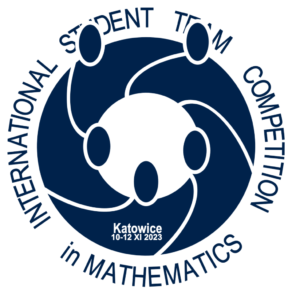On International Student Team Competition in Mathematics
International Student Team Competition in Mathematics is organised annually since 20 at the University of Silesia in Katowice by the Faculty of Science and Technology (previously: Faculty of Mathematics, Physics, and Chemistry) and the Uppersilesian Branch of the Polish Mathematical Society. The goal of the Competition is maintaining a keen interest in mathematics alive, encouraging the development of all mathematically talented students from all participating higher education institutions and countries, supporting friendly relations between higher education students and teachers of participating institutions as well as promotion of cooperation between students and the development of interpersonal skills. The Competition is aimed to all students at any stage of their studies (bachelor’s, master’s and postgraduate) who are interested in mathematics.
The Competition consists of two parts: individual part and team part. Teams can consist of a maximum of five members, who do not have to be from the same university or country. Each team should nominate one of its members as the captain and it should be accompanied by the supervisor who becomes a member of the Jury.
From the very beginning, teams from outside Poland have also participated in the competition. Sicnce 2020 there is a possibility for remote participation in the Competition.
The Competition consists of two parts: individual part and team part. During each day of the competition, participants (or teams) are given 5 tasks (in the individual part) or 10 tasks (in the team part) to solve within 4 hours in the following areas: algebra and combinatorics; mathematical analysis (with topology and set theory); equations and inequalities (including functional and differential equations); geometry and linear algebra; measure theory and probability theory.
2023 Edition
89 participants from 18 different universities from Poland, Austria, Slovakia, Turkmenistan and Great Britain took part in this year’s edition. An additional 54 students from Azerbaijan, Turkmenistan, Ukraine, Uzbekistan and the United Kingdom participated online. A total of 31 teams representing 27 universities from around the world took part in the competition
that took place over two days. On Friday, 10 November, during the individual part, the competitors had to solve five tasks on their own within four hours. On Saturday, 11 November, a team competition took place, during which the competitors, within their team, faced ten tasks within four hours. The competition is held in English, which is an additional difficulty. On the other hand, English is currently the common language of learning around the world, so the competitions organised in Katowice are also an excellent opportunity to test your communication skills in English.
Solve the competition problems
Although the solutions to the tasks often required the ingenious use of advanced mathematical tools and theories, the content of some of them was also understandable to non-mathematicians:
Problem 1 | Individual part
Find all differentiable functions f: R→R satisfying both following equations:
for all x, y∈ R (I) f(x−y)−f(x+y) = 2 f(x+1) f(y+1);
(II) f(x)²+f(x+1)² =1.
Problem 2 | Individual part
Let n be a fixed positive integer. Alice plays the following game. She puts m perfect, symmetric coins into the game. Then she tosses all of them. The bank collects all those with “tail”, and doubles the remaining coins (those with “head”). The process then repeats until either all the coins show “tail”, or Alice has made n tosses. The final gain is the number of remaining coins (i.e. the doubled number of “heads” after the last toss) minus the number of coins Alice put into the game at the beginning.
Find the expected value of Alice’s gain.
Problem 3 | Team part
Billy the beetle walks along the edges of the cube. When it reaches a vertex, it continues along a randomly chosen one of the other two edges emerging from that vertex.
Calculate the number of all distinct paths the beetle can take to return to the starting point for the first time in 2n steps.
Problem 4 | Team part
Let A, B, C, D be four different points on a straight line, in that order.
Show that there exists a square such that two of these points lie on the sides of the square, and two other points lie on the extensions of two other sides of the square (see figure below). Discuss the existence and number of different solutions.
You can try your hand at it yourself…
Results of the competition
On the third day, a ceremony of awarding medals and prizes to the winners took place. The individual part of the competition was won by Thomas Read from the University of Warwick in Coventry, Great Britain, by solving all the tasks and scoring the maximum number of points. Among the participants from the University of Silesia, the best result was achieved by Aleksander Bartnicki, winning the 2nd award and a silver medal.
Team competitors are not awarded medals, but the result achieved in this part, after adding up with the second best result in the individual part, is the final result of the entire team. The winner of the competition is the team “MIM FORCE ONE” from the University of Warsaw (consisting of: Korneliusz Obarski (captain), Cezary Botta, Paweł Pielasa, Antoni Puch) slightly leaving behind the teams “Roots of unity” and “UJ 2” from the Jagiellonian University, and “MIM FORCE TWO”, second team representing the University of Warsaw. All these teams were awarded gold medals.
In the remote part of the competition, the best team was “Victor’s Vectors” from the University of Warwick in Great Britain.
The team “Ślůnskie Rachmajstry” representing the University of Silesia received – similarly to last year – a distinction.
Next year’s edition of the competition will take place, similarly to this year, in early November. We already invite everyone interested!
|photo: archive of the Institute of Mathematics|
|text: Marcin Zygmunt, PhD|






